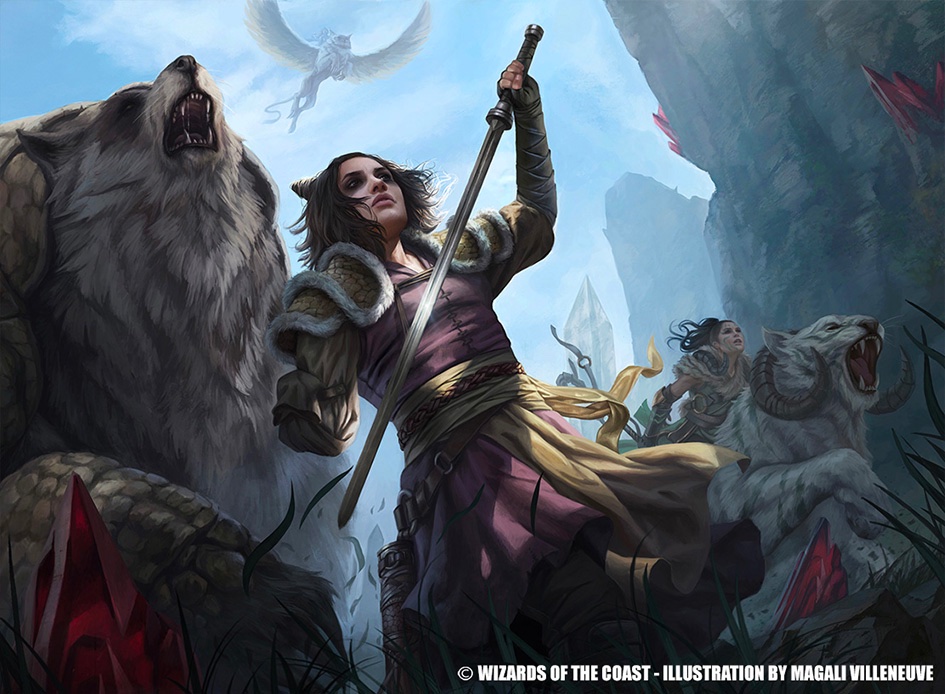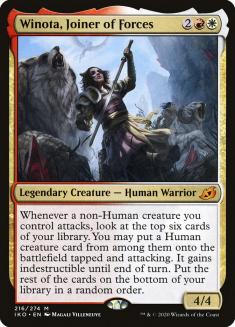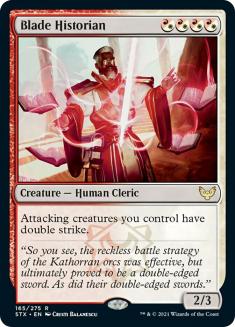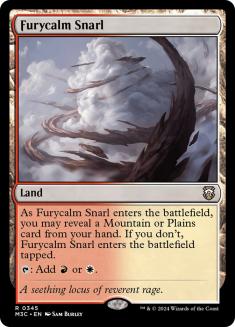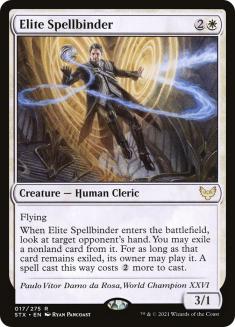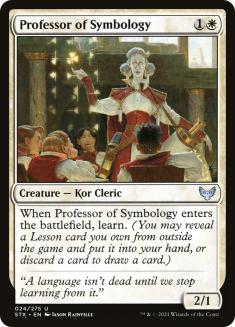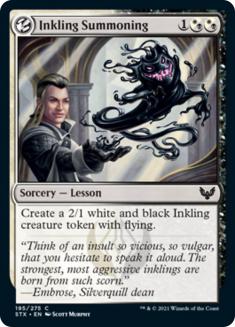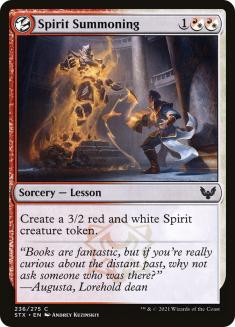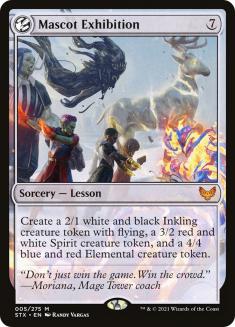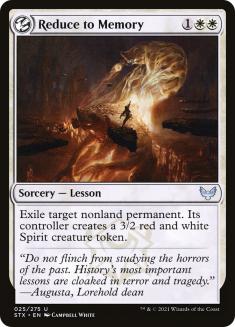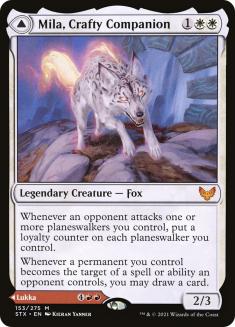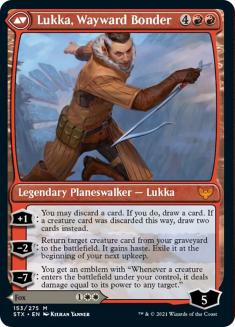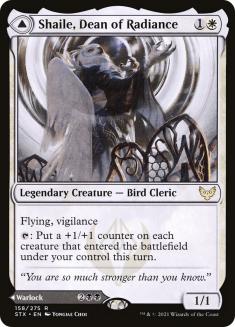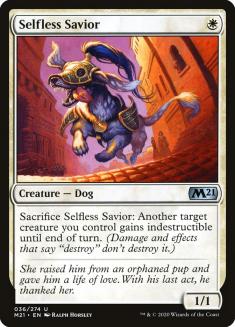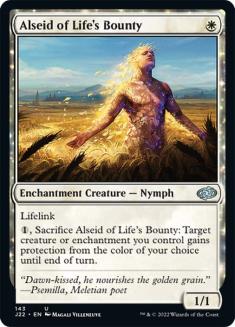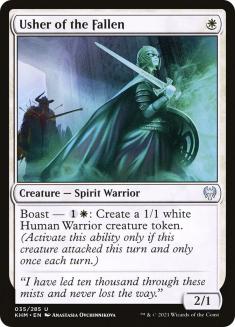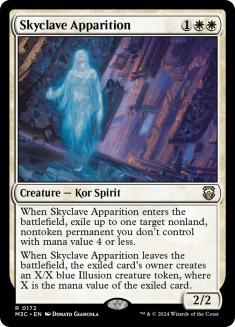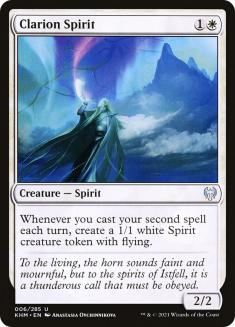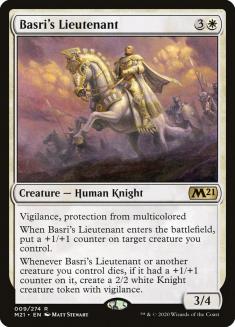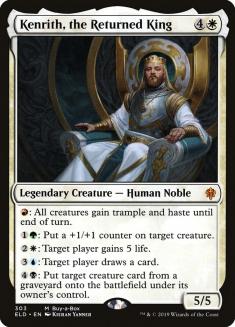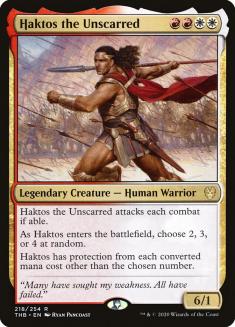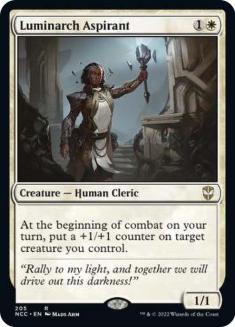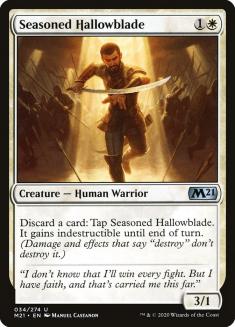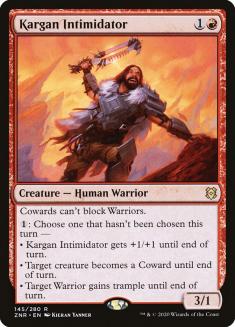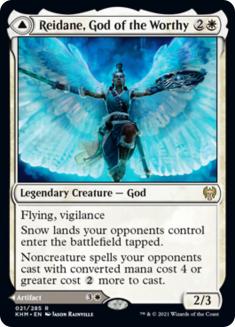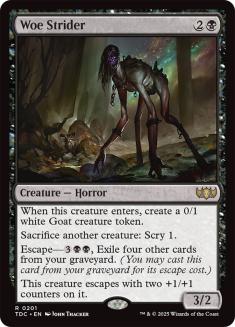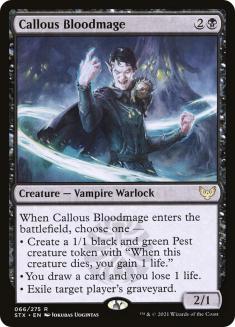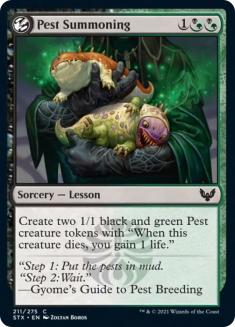Winota, Joiner of Forces is a very powerful card.
Originally it saw play in Standard alongside Agent of Treachery. Once that was banned, it moved to Historic where it made enough waves with Angrath’s Marauders that it also had to be emergency banned. Since then, it has seen fringe play — it’s not a Tier 1 deck by any means, but I do lose to it from time to time on ladder and it always makes me want to smash my keyboard when that happens.
Strixhaven brings us what is arguably the best Human to cheat onto the battlefield since the Agent of Treachery times — Blade Historian.
At face value, Blade Historian is very similar to Angrath’s Marauder in that it doubles your damage output if you cheat it onto the battlefield. However, it does fall short in some aspects — first, it’s only a two-power creature, and second it doesn’t scale with other copies of itself — but it makes up for that by being a much better card to cast. At only four mana, it’s somewhat comparable to Torbran, Thane of Red Fell, a card that has seen ample play at face value, so it’s not going to be an embarrassment to draw (whereas cards like Angrath’s Marauder and Agent of Treachery often are).
Other than that, the ability is actually better in combat because it lets your creatures live. If you attack with Winota into a Bonecrusher Giant and hit Angrath’s Marauder, the Winota is still going to trade, but if you hit Blade Historian, it won’t. When you’re hitting a player, double-damage and double-strike are very similar (scaling issues notwithstanding), but when you’re hitting other creatures, double-strike is superior.
Strixhaven’s Impact
By itself, Blade Historian might not be enough to revitalize Winota decks, but I don’t think it’s the only tool for the deck in the new set. Lorehold is the red and white college, after all, so we are probably going to find new additions in it.
Furycalm Snarl is probably the best of the new multicolor lands, and decks like Winota are the reason why. Boros decks are traditionally hard to build because they’re very color intensive and don’t forgive stumbles, but now that we have another respectable land that produces both colors (even if it’s not the best one we could have had) the possibilities are much more open for us.
The best looking character in Strixhaven can also make an appearance in Winota decks. Ironically Elite Spellbinder would have been better in this deck if it wasn’t a Human, as it’s great at clearing the way for Winota itself, but it’s also a reasonable hit because it stops the opponent from getting back in the game. Sometimes you attack with Winota and hit a bunch of things but not enough to kill them, and then they untap and play something like a Doomskar or an Emergent Ultimatum and you end up losing anyway. If you hit Elite Spellbinder, you make it much more likely that you’ll get another attack step with your Winota, and then that should be enough to win the game.
Elite Spellbinder is also a very reasonable card in your fair plan, particularly in combination with Blade Historian — it can clear the way for the 2/3 and then immediately attack for six damage in the air.
Professor of Symbology is not the most powerful of two-drops, but if you’re looking for a non-Human to get Winota doing then it does the job just fine. If you’re looking for lands or for Winota you can always cycle a card, and if you’re not you can get an extra creature. The most exciting part of this for me is that, by itself, it guarantees a reasonable curve into Winota because there are three-mana cards that make non-Human tokens. Here are the potential Lessons you can play:
These are the three-drops. Going Turn 2 Professor of Symbology into Turn 3 one of those is not the best curve in the world, but it does provide two non-Human attackers with one card. Having Professor of Symbology in your hand is guaranteed to fill your curve in the early-game in the same way Bonecrusher Giant does, though obviously at much less power.
I think you can get by with only one of these, and Inkling Summoning is better if the mana supports it — a 2/1 flyer is more valuable in a Winota deck than 3/2 without any abilities. If you slant towards red, though, I think you should play Spirit Summoning.
I don’t think Environmental Sciences is worth a sideboard slot in this deck. If you need a land, just loot and hope you find it rather than spending an entire turn on it.
Is it worth having a sideboard slot for a late-game target? My inclination is that it won’t be, but this early in the set’s release I’m definitely going to put one of those in my sideboard and see how often it comes up.
A catch-all answer that you can tutor for. May or may not be needed, depending on what ends up seeing play.
As a three-drop, Mila, Crafty Companion is reasonable. It’s a non-Human to enable Winota and the ability will come up, since your opponent can’t just give your Winota free reign. The most interesting part to me is actually the back side, Lukka, Wayward Bonder (specifically the second ability on him).
The ability to get a Winota back for a turn (attacking, even) is huge! Against removal-heavy decks you can actually do this twice before having to plus Lukka. Six mana is a lot, though, so I don’t think this will end up making the cut, but the versatility could be worth it.
Shaile, Dean of Radiance can be a bit of a sleeper card in an aggressive deck. A 1/1 flyer for two mana is obviously bad, but if you play it early in the game, it’s effectively a lord — every subsequent creature is going to have a +1/+1 counter, including the ones that get put onto the battlefield via Winota. It’s probably not good enough, but I do think having non-Humans with evasion is important for Winota, so it’s a contender.
What other cards are we interested in?
The Enablers
Selfless Savior is perfect in Winota decks — it both turns on Winota and protects it. We’re very likely playing four copies and this is the main reason to have white as a primary color instead of red (since the best one-drop in red is Fervent Champion and that’s a Human, so not something you’re very interested in).
This is like Selfless Savior, but much worse as it delays the “combo” by one turn. Still, if we want more of that effect, it’s definitely a consideration.
Another good one-drop. Unfortunately it makes Human tokens, otherwise it would be an automatic four-of as well, but I think it’s still quite good if our base is heavy white.
Winota decks are usually very limited in the amount of interaction they can play — they need a lot of creatures since they’re required to have a high number of non-Humans to enable Winota and a high number of Humans to have it be a payoff. Bonecrusher Giant is a card that lets you keep your creature count high while still having interaction early on. Obviously the card is extremely good and by this point I don’t have to sing its laurels, but it plays a particularly important part here.
Everything I said about Bonecrusher Giant applies here as well — it’s a Winota enabler that’s also interaction.
Anax is very good with Winota, because the tokens are Satyrs and therefore trigger it. Double red is hard to justify in most Winota builds but it’s possible we have one that slants more towards red, in which case it would definitely make the cut.
Unlike Usher of the Fallen, Clarion Spirit makes non-Humans, which is huge for triggering Winota. However, in a straight Boros deck, it’s not super easy to turn it on — you’re not going to have that many cheap cards. The Naya decks with Edgewell Innkeeper, Lovestruck Beast, and Giant Killer do a much better job of that, but they don’t have a very easy time casting Blade Historian.
The Payoffs
Basri’s Lieutenant is a staple in Winota decks — it’s a reasonable card on its own right and a pretty good hit, especially in multiples. As a 3/4 with protection from multicolored, it dodges Giant Killer, Bonecrusher Giant, Shadows’ Verdict, Drown in the Loch, and Binding the Old Gods, so it’s actually a pretty resilient creature. It does make for a lot of four-drops if you also play Blade Historian, but I think we can afford to have some of them.
Kenrith is another Winota staple, and arguably the best Winota hit of them all, but I honestly don’t think we need it in this version. Between Basri’s Lieutenant, Elite Spellbinder, and Blade Historian, I feel like we have enough good hits that we don’t need to play a card just because it’s a good hit. I would play at most one copy.
Another payoff that’s not a super great card to draw. I think we have enough four-drops that we actively want to play that this can sit on the sidelines.
Other Potential Additions
Luminarch Aspirant isn’t payoff or enabler, but it’s such a strong two-mana creature (especially in a deck that already wants to play Selfless Savior) that it’s worth considering on its own. It also combos well with Basri’s Lieutenant, as it can spread counters around to your creatures.
Seasoned Hallowblade is a worse card than Luminarch Aspirant, but a much better Winota hit, especially if you can give it double-strike. Right now I lean towards not playing it, but if the metagame moves away from exile-based removal, it can definitely be worth it.
Kargan Intimidator is a rare creature that works as both enable and payoff — it’s a Human for you to hit, but it can pay one mana to turn itself into a Coward as it attacks. However, it’s not a very good card, so there’s that…
Embercleave can be a good card in a Winota deck but we’re already playing Blade Historian so double strike is a bit redundant. Maul of the Skyclaves works much better with the theme of the deck, though, and if we can spare a card that’s neither an enabler nor a payoff, this is definitely a consideration.
I think Reidane is overall worse than Elite Spellbinder, but it does enable Winota so might be worth playing.
Where To Begin?
In the end, what is this deck looking like? I would start with something like this:
Creatures (37)
- 4 Bonecrusher Giant
- 2 Alseid of Life's Bounty
- 4 Winota, Joiner of Forces
- 3 Basri's Lieutenant
- 4 Selfless Savior
- 4 Skyclave Apparition
- 4 Luminarch Aspirant
- 4 Professor of Symbology
- 4 Elite Spellbinder
- 4 Blade Historian
Lands (22)
Spells (1)

Another potential direction is going Mardu Winota, similar to Michael Jacob’s deck from Players Tour Finals last year. This would be a much more dedicated Winota deck than the Boros build, which is basically a Boros Aggro deck that has Winota for value and for explosive attacks.
The reason to play black is for the cards that produce multiple non-Human attackers. Woe Strider does that while helping you find Winota and Callous Bloodmage can also do the same. You also get an even better three-drop Lesson in Pest Summoning. Now, Professor of Symbology can be responsible for three different non-Human attackers, so a hand of Professor of Symbology, Winota and four lands can realistically kill someone.
Having so many more enablers (as well as cards that can find Winota) means you get to play more payoffs as well, so Kenrith, the Returned King can actually make some sense here (as you’re ideally getting a lot of Winota triggers). This is how such a version would look like:
This deck is going to be much worse at casting Blade Historian (I think realistically you will not cast it Turn 4 very often, but Turn 5 is very doable), but much better at finding it with Winota because of the tokens. The reason there are so many Pathways is because they can make it easier to cast Pest Summoning and also because you have Kenrith, but be careful when playing a non-red or non-white land because of the Historian.
Overall, I believe the Boros version will be better, as it’s a better deck when it doesn’t have Winota, but still probably good enough when you do draw it (plus the whole being able to cast Blade Historian from hand all the time). I’m not sure the deck is good enough to give up Faceless Haven, but I definitely think it’s worth trying now that the mana is better and new tools have emerged.

